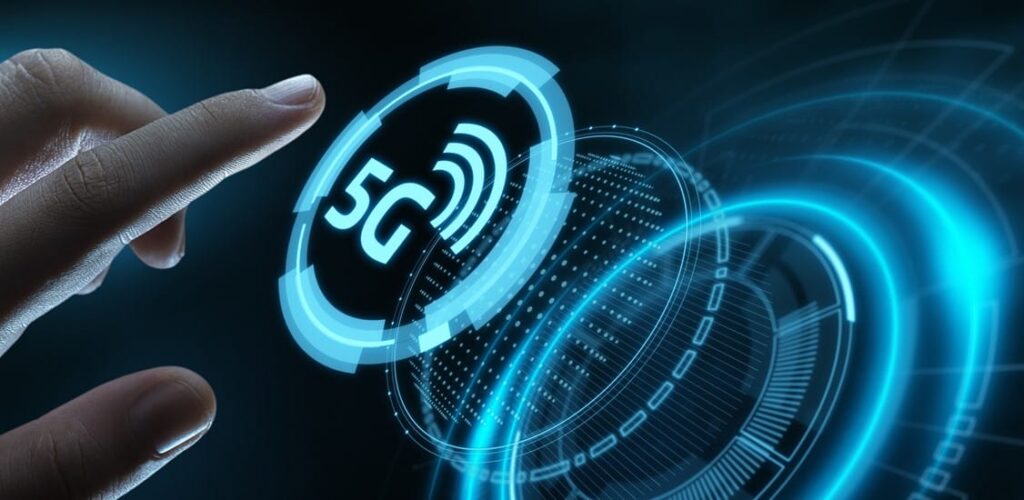Implementing 5G technology
Uncategorized- April 30, 2024
- Geeta University

Implementing 5G technology promises to revolutionize numerous industries, profoundly altering the way we live, work, and interact with technology. In this comprehensive exploration, we’ll delve into the multifaceted impact of 5G across various sectors.With its promise of lightning-fast data speeds, ultra-low latency, and massive connectivity, 5G is poised to revolutionize various industries across the globe. This next-generation wireless technology holds the potential to unlock a multitude of opportunities and transform traditional business models, paving the way for unprecedented levels of innovation and efficiency.
In this blog, we will explore the profound impact of 5G technology on a diverse range of industries, ranging from telecommunications and healthcare to automotive and manufacturing. By delving into specific examples and use cases, we will elucidate how 5G is reshaping the landscape of each sector, driving transformative changes and unlocking new possibilities.

Admission Open 2024-2025
For Your bright Future
1. Telecommunications
The most immediate and apparent beneficiary of 5G technology is the telecommunications industry itself. 5G networks offer significantly faster data speeds, lower latency, and increased capacity compared to previous generations. This translates to smoother streaming, quicker downloads, and more reliable connections for consumers. Telecom companies stand to gain from increased data consumption and the potential for new revenue streams from innovative services enabled by 5G.
2. Healthcare
In the healthcare sector, 5G’s high bandwidth and low latency can facilitate remote patient monitoring, telemedicine consultations, and real-time data transmission. Surgeons could perform complex procedures from different locations using haptic feedback, enabled by the minimal latency of 5G networks. Additionally, the Internet of Medical Things (IoMT) devices, such as wearables and sensors, can provide continuous health monitoring, enhancing preventive care and early detection of health issues.
A. Enhanced Telemedicine:
a. Real-Time Remote Consultations: With its ultra-low latency and high bandwidth capabilities, 5G enables seamless real-time video consultations between patients and healthcare providers. This facilitates remote diagnosis, follow-ups, and monitoring, particularly beneficial for patients in remote areas or with limited mobility.
b. Remote Patient Monitoring (RPM): 5G facilitates continuous RPM by transmitting large volumes of patient data, including vital signs and biometric information, in real-time. This enables proactive healthcare interventions, early detection of abnormalities, and improved disease management, especially for chronic conditions.
B. Advancements in Medical Imaging:
a. High-Resolution Imaging: 5G’s high bandwidth facilitates the transmission of large medical imaging files, such as MRI and CT scans, with minimal latency. This enables remote access to high-resolution images, fostering collaboration among specialists and expediting diagnostic processes.
b. Mobile Imaging Devices: 5G connectivity empowers the development of portable imaging devices capable of transmitting real-time images to healthcare professionals. This facilitates point-of-care diagnostics, especially in emergency situations or underserved areas lacking access to traditional imaging facilities.
c. Remote Surgery: The combination of 5G and robotic surgery allows surgeons to perform complex procedures remotely with precision and accuracy. This breakthrough enhances access to specialized surgical expertise, reduces the need for patient transfers, and minimizes surgical delays, ultimately improving patient outcomes.
C. IoT-enabled Healthcare Ecosystem:
a. Smart Hospitals: 5G enables the interconnection of medical devices, wearables, and infrastructure within smart hospital environments. This facilitates data exchange, automation of workflows, and predictive analytics to optimize resource utilization, streamline operations, and enhance patient experiences.
b. Wearable Health Monitoring: With 5G, wearable devices can transmit real-time health data, such as heart rate, blood pressure, and activity levels, to healthcare providers and electronic health records (EHR) systems. This empowers individuals to proactively manage their health, facilitates early intervention, and supports personalized treatment plans.
D. Accelerated Medical Research and Innovation:
a. Data-driven Insights: 5G enables rapid transfer and analysis of large datasets, including genomics, clinical trials, and electronic health records. This accelerates biomedical research, facilitates data-driven decision-making, and supports the development of personalized medicine approaches tailored to individual patient profiles.
b. Collaborative Research Networks: By connecting researchers and institutions worldwide, 5G fosters collaboration and knowledge sharing, transcending geographical barriers. This facilitates multidisciplinary research endeavors, promotes scientific discovery, and expedites the translation of research findings into clinical practice.
c. Emerging Technologies Integration: 5G serves as a catalyst for integrating emerging technologies, such as artificial intelligence (AI), machine learning (ML), and quantum computing, into healthcare workflows. This synergy enables advanced predictive modeling, drug discovery, and precision medicine applications, paving the way for groundbreaking medical breakthroughs.
E. Addressing Challenges and Considerations:
a. Security and Privacy: The widespread adoption of 5G necessitates robust security measures to safeguard sensitive patient data and mitigate cybersecurity risks, including encryption, authentication, and network segmentation.
b. Infrastructure Investment: Deploying 5G infrastructure requires significant investment in network infrastructure, including towers, antennas, and backend systems, particularly in rural and underserved areas to ensure equitable access to advanced healthcare services.
3. Manufacturing
5G technology holds the promise of transforming manufacturing processes through the implementation of smart factories. With its low latency and high reliability, 5G enables real-time monitoring and control of machinery and robots, optimizing production efficiency and reducing downtime. Furthermore, the integration of 5G with technologies like IoT and AI enhances predictive maintenance capabilities, improving overall equipment effectiveness and reducing maintenance costs.
A. Enhanced Connectivity and Communication:
Low Latency: One of the most significant advantages of 5G technology is its ultra-low latency, which is crucial for real-time communication in manufacturing environments. This low latency ensures swift data transmission, enabling seamless coordination between different stages of production and facilitating responsive decision-making.
High Bandwidth: With its high bandwidth capabilities, 5G enables the transfer of large volumes of data at lightning speed. This empowers manufacturers to harness data-intensive technologies such as high-definition video streaming, virtual reality (VR), and augmented reality (AR) for various applications, including remote assistance, training, and quality control.
Reliability: 5G networks are designed to be highly reliable, with redundant connections and robust security measures. This reliability ensures uninterrupted connectivity, minimizing downtime and optimizing productivity in manufacturing operations.
B. Industry 4.0 and Smart Manufacturing:
Automation: 5G technology serves as a catalyst for the advancement of automation in manufacturing. By providing reliable connectivity to a vast array of sensors, actuators, and robotic systems, 5G enables the seamless integration of machines and processes, leading to greater efficiency, consistency, and scalability.
Digital Twins: 5G facilitates the implementation of digital twin technology, where virtual replicas of physical assets are created and synchronized in real-time. This allows manufacturers to simulate and optimize production processes, predict outcomes, and identify potential issues before they occur, thereby reducing waste and improving overall performance.
C. Internet of Things (IoT) Integration:
Massive Connectivity: With its ability to support a massive number of connected devices per square kilometer, 5G paves the way for the widespread adoption of IoT devices in manufacturing. These devices, ranging from sensors and RFID tags to wearables and autonomous vehicles, generate vast amounts of data that can be leveraged to enhance visibility, traceability, and control throughout the supply chain.
Edge Computing: 5G networks enable edge computing capabilities, allowing data processing and analysis to occur closer to the source of data generation. This distributed computing architecture minimizes latency and bandwidth usage while improving response times, making it ideal for time-sensitive applications in manufacturing, such as quality control and inventory management.
Remote Monitoring and Control: By enabling reliable, high-speed connectivity to remote assets and facilities, 5G enables manufacturers to monitor and control operations from anywhere in the world. This capability is particularly valuable for multinational corporations with geographically dispersed operations, allowing them to centralize management and optimize resource allocation effectively.
D. Supply Chain Optimization:
Real-Time Visibility: With 5G-powered IoT devices and sensors embedded throughout the supply chain, manufacturers gain real-time visibility into the movement and status of raw materials, components, and finished goods. This visibility enables more accurate demand forecasting, inventory management, and production planning, reducing stockouts, overstocking, and lead times.
Smart Warehousing: 5G technology facilitates the implementation of smart warehouse solutions, such as autonomous robots, drones, and inventory management systems. These technologies streamline logistics operations, improve order fulfillment accuracy, and enhance warehouse safety, ultimately driving efficiency and cost savings for manufacturers.
E. Challenges and Considerations:
Infrastructure Requirements: The widespread adoption of 5G technology in manufacturing necessitates significant investments in infrastructure, including upgrading existing networks, deploying new base stations, and implementing edge computing capabilities. Manufacturers must carefully assess these infrastructure requirements and develop strategic partnerships with telecommunications providers and technology vendors to ensure seamless integration and scalability.
Security and Privacy Concerns: As manufacturing systems become increasingly interconnected and reliant on 5G networks, cybersecurity emerges as a critical concern. Manufacturers must prioritize cybersecurity measures, such as encryption, authentication, and intrusion detection, to safeguard sensitive data and intellectual property from cyber threats and unauthorized access.
Skill Gaps and Training: The successful implementation of 5G-enabled technologies in manufacturing requires a skilled workforce capable of designing, deploying, and maintaining these systems. Manufacturers must invest in training and upskilling initiatives to equip employees with the necessary technical expertise and digital literacy to leverage 5G technology effectively.
4. Transportation
The transportation industry stands to benefit significantly from 5G technology, particularly in the realm of autonomous vehicles (AVs). 5G networks can provide the low latency and high data throughput required for real-time communication between vehicles, infrastructure, and other road users. This enables safer and more efficient AV operations, leading to reduced accidents and congestion. Additionally, 5G-powered vehicle-to-everything (V2X) communication facilitates traffic management systems, enhanced navigation, and improved passenger experiences.
5. Entertainment
The entertainment industry is poised for a revolution with the widespread adoption of 5G technology. Streaming services can deliver higher quality video content, including virtual reality (VR) and augmented reality (AR) experiences, thanks to the increased bandwidth and reduced latency of 5G networks. Moreover, immersive gaming experiences and interactive live events can become more pervasive, blurring the lines between physical and digital entertainment realms.
6. Energy
In the energy sector, 5G technology enables the development of smart grids and connected energy infrastructure. Utilities can leverage 5G networks to monitor energy consumption in real-time, optimize distribution, and integrate renewable energy sources more efficiently. Additionally, 5G facilitates the deployment of advanced metering infrastructure (AMI) and enables predictive maintenance of critical infrastructure, enhancing reliability and resilience.
7. Retail
Retailers can harness 5G technology to enhance the shopping experience both online and offline. In-store augmented reality applications can provide personalized product recommendations and immersive shopping experiences, while 5G-enabled inventory management systems improve supply chain efficiency and reduce out-of-stock situations. Furthermore, 5G-powered mobile payments and cashier-less checkout systems streamline transactions and enhance convenience for consumers.
8. Agriculture
5G technology offers significant benefits for the agricultural sector, enabling precision farming and smart agriculture practices. With the help of IoT sensors and drones connected via 5G networks, farmers can monitor soil conditions, crop health, and weather patterns in real-time. This data-driven approach allows for optimized resource allocation, improved crop yields, and sustainable agricultural practices, ultimately enhancing food security and environmental sustainability.
9. Finance
In the financial services industry, 5G technology enhances the speed, security, and reliability of transactions and data processing. High-frequency trading firms can capitalize on 5G’s low latency to execute trades with minimal delay, gaining a competitive edge in the market. Additionally, 5G facilitates the expansion of mobile banking services, enabling secure and convenient access to financial resources, particularly in underserved regions.
10. Education
5G technology has the potential to transform education by enabling immersive and personalized learning experiences. Virtual classrooms, augmented reality textbooks, and interactive educational content can enrich students’ learning experiences, regardless of their geographical location. Moreover, 5G-powered remote learning platforms facilitate access to quality education for learners in remote areas and underserved communities, bridging the digital divide.
Conclusion
The impact of 5G technology extends across a wide range of industries, from telecommunications and healthcare to manufacturing, transportation, entertainment, energy, retail, agriculture, finance, and education. By unlocking unprecedented levels of connectivity, speed, and reliability, 5G has the potential to drive innovation, enhance efficiency, and improve the quality of life for people around the world. As businesses and consumers embrace the opportunities presented by 5G, we can expect to see profound transformations in how we live, work, and interact with technology in the years to come.
Tags
Related Posts

Education trends after Covid 19 – Geeta University
The COVID 19 pandemic flipped the world’s education system upside down this year, causing a significant shift in how pupils learn and teachers teach. Education Trends after Covid 19 The COVID 19 pandemic flipped the world’s education system upside down

The future of Cryptocurrency in India – Geeta University
Gartner, leading research and consulting company, had predicted that the banking industry would receive $ 1 billion in business value in the use of blockchain Crypto currencies by 2022. The Future of Cryptocurrency in India Gartner, leading research and consulting

To be a Civil Engineer one must know – Geeta University
Civil engineering is in high demand for work. Working in this field requires very clear skills. It is not easy to find a great civil engineer and the best are richly rewarded. To Be a Civil Engineer one must know
